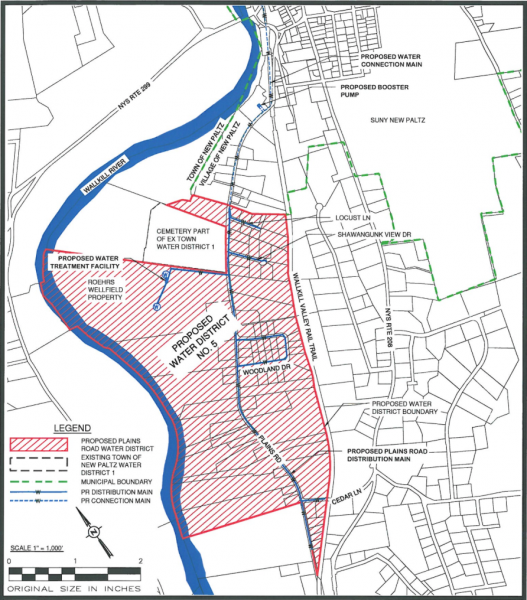
A public hearing was held by the New Paltz Town Board on Dec. 8 in order to receive public comment on the proposed Water District 5 on Plains Road as an alternative water source for the 2017 Catskill Aqueduct shutdown.
The board has decided to move forward with creating the water district and will then continue with the process of designing the system with town engineers and the Department of Environmental Protection (DEP).
Past discussions over a potential water district on Plains Road have been met with much dissent from those living in this area that is comprised of 86 residential properties. However, recently due to a petition circulated by residents of Plains Road who want the implementation of water district, the town board will begin the establishment of the well-based system.
The petition was received by the town board at its regular meeting held on Nov. 19, 2015 and a document entitled Map, Plan and Report in preparation for Water District 5 was created as of the Dec. 8 meeting. The requirements for establishing a water district have been met in accordance with New York State town law article 12, according to the Map, Plan and Report.
In order for this petition to validate the potential decision to commence work on the water district, those who request a district must be comprised of 51 percent or more of residents who live in the area owners as well as 51 percent or more of the assessed property value of resident owners. According to Deputy Supervisor Jeff Logan, the petition submitted exceeds all requirements.
“The water district is the only practical option under current consideration for this one component of the back-up water supply, which is a significantly broader set of plans/actions,” Village Trustee Tom Rocco said. “This has been a very long process of consideration of options to serve the community during the shut downs of the Catskill Aqueduct and more than a two year process of how to assure that the residents of the Plains Road district who might be affected by the use of the aquifer in that area would be more than adequately protected.”
The extent of the water available in the Plains Road aquifer was discovered in August 2013, according to Rocco. The monitored test followed and then was accepted by New York Department of Environmental Conservation (DEC) and New York Department of Health (DOH).
The Town of New Paltz is 25 square miles and is provided with water from the Catskill Aqueduct along with the village’s reservoir system and water treatment facilities which are located off Mountain Rest Road. Although a village reservoir exists, the village is authorized to withdraw water from the Catskill Aqueduct under terms and conditions of a formal agreement NYC. The total water usage of the village, SUNY New Paltz and town combined is 800,000 gallons per day.
“One of the unique opportunities of this water district is that it is 100 percent funded by the DEP as part of the backup water supply needed while the DEP aqueduct is shut down for repair,” Logan said. “Under most cases, the residents, when getting a water district, would have to pay the capital costs of developing the district.”
According to Logan, these capital costs are valued at $10 million. In the case of Plains Road, the DEP is funding $125,000 to run the system and cover maintenance fees, supplementary to developing it. However, according to the document entitled “Questions for Town Board; Proposed Water District 5,” found on townofnewpaltz.org, this contribution will apply to the first 6,000 gallons of water usage per month per water district customer.
As a result, residents will not receive any water bills for five to six years. Following the five to six year period, the annual cost to each water district customer is estimated to be $216 based on the average use anticipated for a customer that owns a typical three-bedroom single family home, according to the Map, Plan and Report document.
Aqueduct shutdowns to commence in Oct. 2017 for a maximum shutdown period of 10 weeks. These shutdowns will then reoccur for two more 10 week periods in 2018 and 2019.
